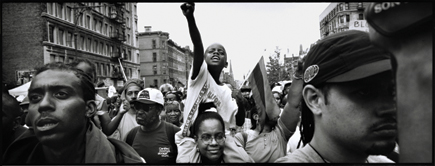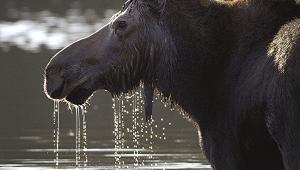The Photography Of Eli Reed; A Passion For Storytelling
As a documentary photographer Eli Reed focuses on subjects that have deep meaning for him. A member of Magnum since 1983, Reed is a highly respected still photographer as well as a noted member of the motion picture industry where he works with some of Hollywood's top directors, including John Singleton and Spike Lee. Photojournalist Dirck Halstead wrote of Reed, "Eli Reed is a case study in how photojournalists can follow their hearts, do good work, and still make a living."
U.S.A. New York City, 1999 - Million Youth
March |
|
 |
|
|
Getting his visual images out into the world is of prime importance to Reed.
Making some connection is important to him, and his passion for storytelling
and his eye for the honesty of feeling are well-known. His focus has been mainly
on being black in America and on the lives of children who have never had the
opportunity to live in the way to which they are entitled. Reed's identification
with his subjects brings to life moments where he had strongly reacted and was
able to document a meaningful image.
"Being a photographer is an obligation," Reed says, "not a
mission. Having worked with organizations such as Save the Children and Doctors
Without Borders, I want people to understand that. It is a project dear to my
heart to do what I can for the less fortunate in this world.
"Kids," he says, "are naturally cute, so that's an easy
one. They are innocent and beautiful. I never try to make them cute and if they
come out that way it is an accident, but an accident that was bound to happen."
Lebanon, Beirut - 1983 |
 |
He speaks often about the fragility of children. "Kids are not always
that image we expect. They need protection. Some have seen little of what the
world has to offer in terms of happiness. It is wonderful to look at the beauty,
the love and joy--that's fine but it's not always dealing with
a full deck."
One of Reed's favorite photographs shows two children in bed. "Kids
run and play and all that kind of stuff," he says, "but a lot of
these families have a difficult situation. They may smile and in one picture
the older kid was smiling but when he goes to sleep all of his problems come
in."
In a body of work done in Northern England, which helped to provide food for
starving children, Reed photographed a
14-year-old girl. She had been prostituting for over a year. Another image showed
a young psychopath who had the potential to kill if given the opportunity. "One
could see the child's beautiful, stoic face and never know his potential
to be a killer," Reed recalls. "These are the things that invite
questions I always have to ask, `What are we seeing or what are we really
seeing?'
"On a happier note there are times I walk down the street or I am at
the airport and there's a beautiful child on someone's shoulder
and they are staring at me. I feel we are kindred spirits. We look at each other
and we smile at the same time. These are deep and poignant moments."
Reed has photographed children around the globe, always trying to get the purity
without the over-the-top nonsense. "I look at them in a very simplistic
way though I know with the children it is always complicated," he says.
"It is important to realize they are individual human beings and we hope
in many cases they will come out on the other side.
Kenya & U.S.A. 2001 - Lost Boys Of Sudan |
 |
"Sometimes I am not happy when some of my photographs are published because they are the simplest, safest ones. Acceptable pictures can be uncomfortable for me. People like Robert Frank and Gene Richards have pushed the envelope with pictures that are `in your face' rather than safe, secure, free rides and I admire that."
One of Reed's most powerful works is an hour-long documentary titled
"America's Children--Poorest in the Land of Plenty" that
aired on NBC. Done for the National Churches of Christ and narrated by Maya
Angelou, the documentary was directed by Scott Fraser.
"I can't say enough good things about Eli," Fraser says. "He
is brilliant and working with him was a privilege. I chose to work with Eli
after looking at the work of many fine photographers. I chose him because of
the way he captures reality in his lens.
"The decision to put stills into the documentary was a way to respectfully
talk to people who were in a lot of pain. I didn't want to be too invasive
so I kept a respectful distance. Eli's photographs allowed me to do that
as a filmmaker. The black and white photographs truly conveyed who these people
were.
"It is Eli's incredible eye, his empathy for the people he sees through his camera lens, and how he composes so beautifully. He is a great craftsman and knows how to pull these wonderful, dense black prints. They were among the things that convinced me to select him to work with me."
- Log in or register to post comments

















































